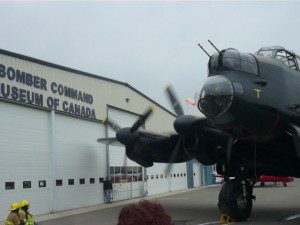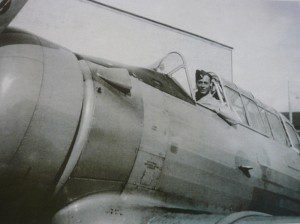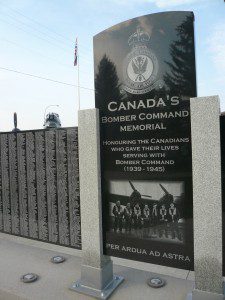
I had hardly oriented myself to the place. Wood smoke from the recent B.C. fires had left Nanton, Alberta – a small prairie town south of Calgary – in a palpable haze. Nevertheless, aviation enthusiast Karl Kjarsgaard, who lives and volunteers there, had something he wanted to show me. Inside the newly renamed Bomber Command Museum of Canada, he led me to a storage area above the workshop. He opened a cardboard box and pulled out a metal bar about 18 inches long.
“This aluminum ingot has Canadian blood in it,” he said. “There’s 1,400 pounds of melted down aluminum in this box… and some of it is about to become famous.”
In 1997, Kjarsgaard and a recovery team drained a swamp near Schendelbeke, in Belgium. Their objective was to retrieve a Halifax bomber, LW682, shot down in 1944 by Luftwaffe fighters following a night-time bombing raid against military targets in German-occupied Europe.

Once the remains of the dead air crew (including three Canadians) had been removed from the wreck and buried with military honours at Geraardsbergen, nearly a ton of aluminum debris was left over at the crash site. Kjarsgaard had the bomber metal melted into the ingots and shipped to Canada’s only museum paying tribute to Second World War Canadian bomber crews.
“I’ve always had an interest in the Halifax bomber crews of Bomber Command,” Kjarsgaard told me this past weekend.
On Friday and Saturday, I travelled to the Bomber Command Museum in Nanton to speak in tribute to the men who had trained nearly a quarter of a million airmen as military pilots, navigators, wireless radio operators, gunners, flight engineers and ground crew during the war.

Many of those trainees – about one in four Allied airmen – were Canadians. They’re the ones that Kjarsgaard and this little museum in the middle of the prairies have commemorated since 1986. Dave Birrell, a longtime member of the museum, described how things got started.
“It all began back in 1960, when three guys [George White, Howie Armstrong and Fred Garratt] purchased a Lancaster bomber from a nearby air base for $513,” Birrell said. “Then they hauled it about 25 kilometres overland to the Town of Nanton.”
Parked by the highway and unattended, the bomber relic fell prey to vandals. They removed its instruments and interior equipment, and then destroyed the cockpit, turret and bomb-aimer perspex. Like its wartime legacy, Nanton’s Lanc lay stripped and nearly forgotten. Then volunteers began protecting its remnants and restoring its missing elements. They mounted the Lanc on a pedestal and donated it to the town. And, in the 1980s when people began rediscovering Canadian war birds, the Nanton Lancaster Society Air Museum, began displaying its museum piece on annual Open Bomber Days.
“These were most successful,” the society website explained, “with long lines forming at the ladder leading to the cockpit. The aircraft’s role in the education of future generations had begun.”
The little museum that could began to grow. The local Legion got involved. Various corporations pitched in. Even the three levels of government co-operated to help preserve the Lancaster, raise the money for a permanent hangar to house aircraft and even raise the level of awareness of Canada’s Bomber Command history.
There are perhaps a thousand card-carrying official museum members, but the heart and soul of the museum remains its volunteer base. Every Tuesday night for two decades, maybe 25 die-hard members of the museum gather to tinker with aircraft fuselages or air engines.
“As big as we’ve become,” Birrell said, “we still depend on the goodwill of folks in the community. If we need a truck or a welder, we just ask in town and people volunteer.”

That’s partly why Karl Kjarsgaard has recently pulled up stakes at his long-time home in Ottawa and moved permanently to Nanton, Alberta. As part of his move, Kjarsgaard joined the museum’s effort to create the nation’s only bomber crew commemorative wall. Five years ago this week, members of the Bomber Command Museum of Canada unveiled five panels of three-inch thick, polished black granite in front of the museum. Each panel displays the names of 1,600 Canadians (10,000 in all) killed in air operations during the Second World War.
“I’ve moved to Nanton, because the people here are the best at what they do and because of the wall. Now I’m part of that team,” Kjarsgaard said.
And it appears the rest of the world is watching. Kjarsgaard explained that the United Kingdom has recently decided to erect its first ever memorial to Bomber Command. The Brits have agreed to use 600 pounds of Nanton’s aluminum ingots – the bars in the workshop – to build a commemorative archway in front of their planned monument at London’s Green Park.
“Our Canadian bomber crews will finally be front and centre in the U.K. where they served,” he said.
I just wanted to say that the work Karl and his team is doing is wonderful. I went to Selkirk College with Karl and know that he is a very unique individual. He was so intensely interested in bombers and war planes then and to see him full fill his dreams is remarkable. I respect what he has accomplished. Thank you for this article!